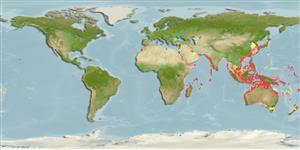Teleostei (teleosts) >
Eupercaria/misc (Various families in series Eupercaria) >
Labridae (Wrasses) > Cheilininae
Etymology: Pteragogus: Greek, pteron = wing, fin + Greek, ago = to drive (Ref. 45335).
More on author: Valenciennes.
Environment: milieu / climate zone / depth range / distribution range
Ecology
Marine; reef-associated; depth range 2 - 78 m (Ref. 86942). Tropical
Indo-West Pacific: Red Sea to South Africa (Ref. 35918) and Papua New Guinea, north to southern Japan, south to Australia.
Size / Weight / Age
Maturity: Lm ? range ? - ? cm
Max length : 20.0 cm TL male/unsexed; (Ref. 4392); 15.0 cm TL (female)
Found among algae patches of coral or rocky reefs (Ref. 9710). Also found in weedy bottoms (Ref. 30573). Cryptic and with excellent camouflage, making it difficult to detect (Ref. 90102). Males territorial (Ref. 9710). Edible but not tasty (Ref. 559). Female length is from Ref. 9137.
Life cycle and mating behavior
Maturities | Reproduction | Spawnings | Egg(s) | Fecundities | Larvae
Oviparous, distinct pairing during breeding (Ref. 205).
Randall, J.E., 1986. Labridae. p. 683-706. In M.M. Smith and P.C. Heemstra (eds.) Smiths' sea fishes. Springer-Verlag, Berlin. (Ref. 4392)
IUCN Red List Status (Ref. 130435)
Threat to humans
Harmless
Human uses
Fisheries: commercial; gamefish: yes; aquarium: commercial
Tools
Special reports
Download XML
Internet sources
Estimates based on models
Preferred temperature (Ref.
123201): 21.5 - 28.8, mean 27.2 °C (based on 1000 cells).
Phylogenetic diversity index (Ref.
82804): PD
50 = 0.5010 [Uniqueness, from 0.5 = low to 2.0 = high].
Bayesian length-weight: a=0.01585 (0.00707 - 0.03555), b=2.95 (2.76 - 3.14), in cm total length, based on LWR estimates for this (Sub)family-body shape (Ref.
93245).
Trophic level (Ref.
69278): 3.5 ±0.37 se; based on food items.
Resilience (Ref.
120179): Medium, minimum population doubling time 1.4 - 4.4 years (Preliminary K or Fecundity.).
Fishing Vulnerability (Ref.
59153): Low vulnerability (10 of 100).
Nutrients (Ref.
124155): Calcium = 66.8 [40.8, 110.7] mg/100g; Iron = 0.655 [0.390, 1.181] mg/100g; Protein = 18.5 [15.6, 20.6] %; Omega3 = 0.165 [0.109, 0.249] g/100g; Selenium = 29.8 [18.5, 50.6] μg/100g; VitaminA = 130 [40, 483] μg/100g; Zinc = 1.52 [1.07, 2.36] mg/100g (wet weight);
